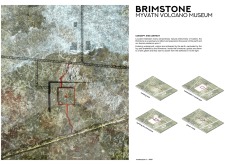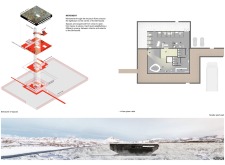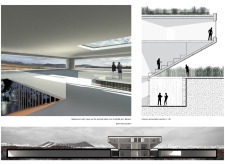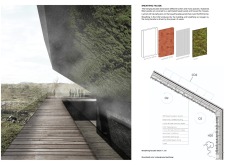5 key facts about this project
The Brimstone Myvatn Volcano Museum is located in Iceland, an area famous for its unique geological features and dramatic landscapes. The design aims to create a space that allows visitors to connect with the earth. The overall concept is focused on immersion, inviting guests to enter the museum through an underground passage that gives the feeling of being surrounded by nature, leading them from darkness into light.
Conceptual Framework
The layout of the museum revolves around a central beam of light that guides movement throughout the space. This organization leads visitors through a series of areas that range from intimate to open, creating a natural flow. The design emphasizes a harmonious relationship with the volcanic landscape, enhancing the visitors' experience as they navigate through the various sections.
Functional Areas
Multiple functional spaces are incorporated into the museum's design, including a green roof, open office spaces, an entrance hall, a restaurant, a moss facade, and outdoor boardwalks. Each of these areas serves a specific purpose while contributing to the overall visitor experience. The restaurant is positioned to offer views of natural baths, Hverfjall, and Lake Mývatn, effectively tying the interior experience to the scenic exterior.
Living Facade
A notable feature of the Brimstone is its Breathing Facade, which displays different lichen and moss species. This facade is made of panels filled with substrate that support the mosses, all covered by perforated basalt. This design allows lichen to grow naturally, making it a living entity that interacts with its surroundings. The facade enhances the building’s appearance while being environmentally friendly by absorbing carbon dioxide and releasing oxygen.
Materials and Integration
The design uses basalt, clay, and natural elements like moss and lichen to strengthen the connection to the environment. Each material is chosen for its function and visual impact. This careful selection ensures that the museum not only provides shelter for visitors but also reflects the geological character of the area, deepening the understanding of the natural forces that have shaped it.
The moss and lichen on the Breathing Facade illustrate a connection to nature, creating a dialogue between the building and its landscape.





















































